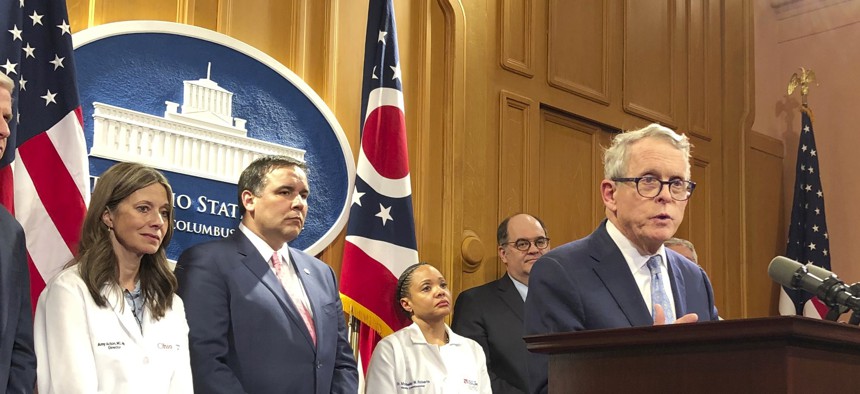The Pandemic Reminds Us Why Governors Still Matter

Ohio Gov. Mike DeWine news conference on coronavirus. Governors across the country have stepped up as leaders during the pandemic. AP PHOTO/Julie Carr Smyth
COMMENTARY | Governors across the United States have taken a proactive, hands-on response to the coronavirus pandemic.
In recent years, governors haven’t seemed particularly vital to the national political conversation. They often seemed absent or ineffectual on several key debates, most notably the unsuccessful fight to preserve state and local tax deductions in the 2017 federal tax reform bill. Once automatically counted as major contenders for president, this year saw multiple governors fail to get any traction in the Democratic primary.
Even in their respective states, governors have had less opportunities to be relevant as the bulk of state budgets are dedicated to mandatory programs, limiting the ability for state chief executives to push forward new and innovative ideas.
This lack of visibility and relevance prompted Maryland Gov. Larry Hogan, chair of the National Governors Association (NGA), the bipartisan organization that represents governors’ collective interest, to make elevating the profile of governors a priority of his chairmanship.
In full disclosure, I spent nearly a decade working for the nation’s governors at NGA focused on supporting governors’ homeland security advisors in homeland security, emergency management and public health preparedness. Yet, as my career shifted more toward working with local government officials, I, too, questioned the relevance of governors.
Then came the coronavirus.
Since the first cases of Covid-19 appeared in the United States, governors have been front and center. The potential scale and spread of the disease demanded statewide intervention. Taking a look at governors’ actions to date shows that all governors have declared a state of emergency or public health emergency. More than one-third have activated their National Guard and/or restricted state employee travel.
Where President Trump’s response to the pandemic has lacked urgency and lagged behind developments on the ground, governors’ actions have been science-based and focused on the quickly evolving recommendations from public health officials.
Hard choices have had to be made that are far-reaching and carry significant consequences for local economies. But faced with the prospect of a worsening crisis that could bring the nation’s health care system to its breaking point, governors have made bold choices in an attempt to "flatten the curve" and slow the virus’ spread. Ohio Gov. Mike DeWine led the way with ordering all schools closed statewide, then again took the step to close down bars and restaurants after revelers partied through the weekend. Hogan was not far behind him on both schools and cracking down on nightlife, while New York Gov. Andrew Cuomo created the nation’s first “containment zone” to shut down public spaces in a particularly hard-hit area.
Governors also have navigated a variety of challenges from the lack of testing capability, the slow federal response and the relatively uncharted territory of managing a pandemic in the technological era. Yet, that hasn’t stopped governors and their staff from getting creative in addressing those challenges. From Washington state's efforts to work with closing schools to provide meals and child care to Colorado setting up one of the first drive-thru testing centers, governors are showing the country that states are still the “laboratories of democracy” even in emergencies.
These actions have positioned governors as the public faces of the crisis response. While not always perfect—see Oklahoma Gov. Kevin Stitt's recent tweet celebrating eating out on Saturday night in a crowded restaurant—they have been present in regular press briefings and on social media. And they have advocated vigorously for the federal government to provide more swift assistance to states. These actions have not gone unnoticed and, in some instances, been heralded by political rivals least likely to shower governors with praise.
We are still in the early stages of the pandemic. More decisions and obstacles are on the horizon. But, for now, governors are rising to the occasion and are offering the leadership we need to weather this unprecedented crisis.
OTHER STORIES on Route Fifty:
Alisha Powell Gillis is the senior editor for Route Fifty.
NEXT STORY: Colorado Offers Guidance to Other Governments That Want to Establish Drive-Thru Testing






